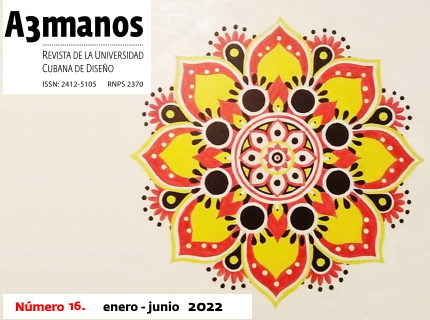The Kendall statistician and his application. A practical example.
##plugins.themes.bootstrap3.article.main##
Abstract
Given the need to increase the use of scientific methods during the design process, it has been proposed to explain through an example of the practice of this discipline, the use of the Kendall statistician for decision-making, an element in which designers constantly they are immersed during their professional performance and why not during their time at the academy. This process goes through the planning and carrying out of various activities that will vary according to the design commission and organized by phases and stages according to different authors. Design ceased to be an intuitive and casual discipline, becoming a scientific discipline and therefore all the authors of the teaching process must be involved in understanding it and materializing it in their performance with students. From the moment that the designer faces different problems to give him an "optimal" solution, he is already obliged to use methods that lead him safely to that solution, because it should not be the product of chance, but must be based on methods that allow you to save resources, obtain better product performance, achieve recyclable materials that are not harmful to the environment. All this requires having mathematical tools and the consultation of those who consider themselves experts in the field of knowing what is being dealt with, starting from the search for information and compilation of the most interesting, to the selection of the optimal solution. To reach these conclusions, the designer should not start from his personal criteria, and even more so if his experience is not entirely broad, for this he must resort to proven statistical methods, which will surely make him take the right path regarding a selection. alternative previously agreed upon. Due to the aforementioned, the objective of this work consists of: Familiarizing designers with the use of a statistician that helps to obtain consensus among experts on a certain question, to apply it to their design projects when required.
##plugins.themes.bootstrap3.article.details##

This work is licensed under a Creative Commons Attribution-NonCommercial-ShareAlike 4.0 International License.
- Attribution — You must give appropriate credit , provide a link to the license, and indicate if changes were made . You may do so in any reasonable manner, but not in any way that suggests the licensor endorses you or your use.
- NonCommercial — You may not use the material for commercial purposes .
- No additional restrictions — You may not apply legal terms or technological measures that legally restrict others from doing anything the license permits.
- ShareAlike — If you remix, transform, or build upon the material, you must distribute your contribution under the same license as the original. NOTE: This point applies to numbers 1 to 20 of the magazine with the previous CC-BY-NC-SA 4.0 license. Does not apply to the new CC BY-NC 4.0 license from Volume 11, Number. 21 (2024).
References
Florés, B., & Puig, A. (2008). ¿Hacia dónde se dirige la función de calidad?: la visión de expertos en un estudio Delphi. Revista Europea de Dirección y Economía de la Empresa, 18 (2), 13-38.
Eames, C., Daley, D., Hutchings, J., Whitaker, C.J., Bywater, T., Jones, K. & Hughes, J.C. (2010). The impact of group leaders’ behaviour on parents acquisition of key parenting skills during parent training. Behaviour Research and Therapy, 48, 1221-1226.
García, V., Aquino, S., Guzmán, A. & Medina, A. (2012). El uso del método Delphi como estrategia para la valoración de indicadores de calidad en programas educativos a Distancia.
Revista Calidad en la Educación Superior, 3 (1), 200 – 222.
González, I. & López, I. (2010). Validación y propuesta de un modelo de indicadores de evaluación de la calidad en la universidad. Revista Iberoamericana de Educación.
Landeta, J. (2006). Current validity of the Delphi method in social sciences. Technological Forecasting and Social Change, 73 (5), 467-482.
Rosas, A., Sánchez, J. & Chávez, M. (2012). La técnica Delphi y el análisis de la capacidad institucional de gobiernos locales que atienden el cambio climático. Política y Cultura, 38, 165-194.
Rowe, G. & Wright, G. (2012). The Delphi technique: Past, present, and future prospects
— Introduction to the special issue. Technological Forecasting and Social Change, 78 (9), 1487-
Shapiro, C., Prinz, R. & Sanders, M. (2012). Facilitators and Barriers to Implementation of an Evidence-Based Parenting Intervention to Prevent Child Maltreatment: The Triple P-Positive Parenting Program. Child Maltreatment, 17 (1), 86-95.
Small, S., Cooney, S. & O’Connor, C. (2009). Evidence-Informed Program Improvement: Using Principles of Effectiveness to Enhance the Quality and Impact of Family-Based Prevention Programs. Family Relations, 58, 1-13.
Turner, K., Nicholson, J. & Sanders, M. (2011). The Role of Practitioner Self-Efcacy, Tra- ining, Program and Workplace Factors on the Implementation of an Evidence-Based Parenting Intervention in Primary Care. Journal of Primary Prevention, 32, 95–112. Turner, K. & Sanders, M. (2006). Dissemination of evidence-based parenting and fami- ly support strategies: Learning from the Triple P—Positive Parenting Program system approach. Aggression and Violent Behavior, 11, 176– 193
























